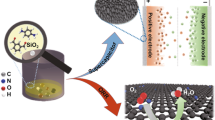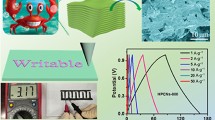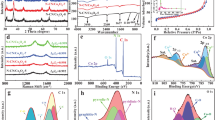Abstract
A green and sustainable approach was employed to synthesize N, O-codoped porous carbon nanorods with two-end-open characteristics. In this method, a crab shell was utilized as a template and activator, while egg white served as a carbon precursor. The resulting carbon nanorods sintered at 700 °C (CNRs-700), exhibited cross-linked pore channels, a high surface area, and abundant defects and active sites. These features imparted superior energy storage properties to the material, enabling its application as both an anode for lithium-ion batteries and a supercapacitor. The CNRs-700 demonstrated an exceptional lithium storage capacity of 530.6 mAh g−1 at 2 A g−1, corresponding to 90.1% of the capacity achieved at 100 mA g−1, which is ascribed to the pseudocapacitive contribution. Furthermore, in an evaluation combining a three-electrode configuration in KOH electrolyte at a high current density of 50 A g−1, the CNRs-700 retained a specific capacitance of 140 F g−1. For symmetrical supercapacitors based on CNRs-700 in 1 M Na2SO4 electrolyte, the energy density reached 27.1 Wh kg−1 at a 375 W kg−1 power density, demonstrating remarkable cyclability over 10,000 consecutive cycles. The superior rate performance and cycling stability would accentuate the suitability of the biomass-derived carbon materials for such systems.
Graphical Abstract









Similar content being viewed by others
References
Gui QQ, Feng YT, Chen BJ, Gu F, Chen L, Meng S, Xu M, Xia MT, Zhang C, Yang JH (2021) Extrinsic-structured bimetallic-phase ternary metal phosphorus trisulfides coupled with N-doped graphitized carbon for superior electrochemical lithium Storage. Adv Energy Mater 11:2003553. https://doi.org/10.1002/202003553.aenm
Wei L, Sevilla M, Fuertes AB, Mokaya R, Yushin G (2012) Polypyrrole-derived activated carbons for high-performance electrical double-layer capacitors with ionic liquid electrolyte. Adv Funct Mater 22:827–834. https://doi.org/10.1002/adfm.201101866
Cai XY, Lai LF, Shen ZX, Lin JY (2017) Graphene and graphene-based composites as Li-ion battery electrode materials and their application in full cells. J Mater Chem A 5:15423–15446. https://doi.org/10.1039/C7TA04354F
Kshetri T, Thanh TD, BobbySingh S, HoonKim N, HeeLee J (2018) Hierarchical material of carbon nanotubes grown on carbon nanofibers for high performance electrochemical capacitor. Chem Eng J 345:39–47. https://doi.org/10.1016/j.cej.2018.03.143
Romano V, Martín-García B, Bellani S, Luigi M, Panda JK, Oropesa-Nuñez R, Najafi L, Del Rio Castillo AE, Prato M, Mantero E, Pellegrini V, D’Angelo G, Bonaccorso F (2019) Flexible graphene/carbon nanotube electrochemical double-layer capacitors with ultrahigh areal performance. ChemPlusChem 84:882–892. https://doi.org/10.1002/cplu.201900235
Xia Y, Zhao TC, Zhu XH, Zhao YJ, He HL, Hung C, Zhang XM, Chen Y, Tang XL, Wang JX, Li W, Zhao DY (2021) Inorganic-organic competitive coating strategy derived uniform hollow gradient-structured ferroferric oxide-carbon nanospheres for ultra-fast and long-term lithium-ion battery. Nat Commun 12:1–10. https://doi.org/10.1038/s41467-021-23150-8
Yu F, Liu ZC, Zhou RW, Tan DM, Wang HX, Wang FX (2018) Pseudocapacitance contribution in boron-doped graphite sheets for anion storage enables high-performance sodium-ion capacitors. Mater Horiz 5:529–535. https://doi.org/10.1039/c8mh00156a
Zheng YL, Wang HL, Sun SJ, Lu GF, Liu HL, Huang MH, Shi J, Liu W, Li HY (2020) Sustainable nitrogen-doped carbon electrodes for use in high-performance supercapacitors and Li-ion capacitors. Sustain Energy Fuels 4:1789–1800. https://doi.org/10.1039/C9SE01064E
Balaji SS, Karnan M, Anandhaganesh P, Tauquira SM, Sathish M (2019) Performance evaluation of B-doped graphene prepared via two different methods in symmetric supercapacitor using various electrolytes. Appl Surf Sci 491:560–569. https://doi.org/10.1016/j.apsusc.2019.06.151
Mofokeng TP, Tetana ZN, Ozoemena KI (2020) Defective 3D nitrogen-doped carbon nanotube-carbon fibre networks for high-performance supercapacitor: transformative role of nitrogen-doping from surface-confined to diffusive kinetics. Carbon 169:312–326. https://doi.org/10.1016/j.carbon.2020.07.049
Sun JF, Xu QQ, Qi JL, Zhou D, Zhu HY, Yin JZ (2020) Isolated single atoms anchored on N-doped carbon materials as a highly efficient catalyst for electrochemical and organic reactions. ACS Sustain Chem Eng 8:14630–14656. https://doi.org/10.1021/acssuschemeng.0c04324
Du J, Liu L, Hu ZP, Yu YF, Zhang Y, Hou SL, Chen AB (2018) Raw cotton derived N-doped carbon fiber aerogel as efficient electrode for electrochemical capacitors. ACS Sustain Chem Eng 6:4008–4015. https://doi.org/10.1021/acssuschemeng.7b04396
Zhao CJ, Liu GQ, Sun N, Zhang X, Wang GZ, Zhang YX, Zhang HM, Zhao HJ (2018) Biomass-derived N-doped porous carbon as electrode materials for Zn-air battery powered capacitive deionization. Chem Eng J 334:1270–1280. https://doi.org/10.1016/j.cej.2017.11.069
Liu JW, Min SX, Wang F, Zhang ZG (2020) Biomass-derived three-dimensional porous carbon membrane electrode for high-performance aqueous super-capacitors: an alternative of powdery carbon materials. J Power Sources 466:228347. https://doi.org/10.1016/j.jpowsour.2020.228347
Yang Z, Xiang M, Zhu W, Hui J, Qin HF (2020) Biomass heteroatom carbon/cerium dioxide composite nanomaterials electrode for high-performance supercapacitors. ACS Sustain Chem Eng 8:6675–6681. https://doi.org/10.1021/acssuschemeng.0c00188
Du BY, Zhu HW, Chai LF, Cheng JL, Wang X, Chen XH, Zhou JH, Sun RC (2021) Effect of lignin structure in different biomass resources on the performance of lignin-based carbon nanofibers as supercapacitor electrode. Ind Crops Prod 170:113745. https://doi.org/10.1016/j.indcrop.2021.113745
Chen MJ, Wang S, Zhang HY, Zhang P, Tian ZQ, Lu M, Xie XJ, Huang W (2020) Intrinsic defects in biomass-derived carbons facilitate electroreduction of CO2. Nano Res 13:729–735. https://doi.org/10.1007/s12274-020-2683-2
Li B, Dai F, Xiao QF, Yang L, Shen JM, Zhang CM, Cai M (2016) Activated carbon from biomass transfer for high-energy density lithium-ion supercapacitor. Adv Energy Mater 6:1600802. https://doi.org/10.1002/aenm.201600802
Vahdati-Khajeh S, Zirak M, Tejrag RZ, Fathi A, Lamei K, Eftekhari-Sis B (2019) Bio-compatible magnetic N-rich activated carbon from egg white biomass and sucrose: preparation, characterization and investigation of dye adsorption capacity from aqueous solution. Surf Interfaces 15:157–165. https://doi.org/10.1016/j.surfin.2019.03.003
Su XJ, Lin HT, Fu BF, Mei SS, Chen HB, Zheng ZP, Bo HY, Yang D, Lin YF (2023) Egg-yolk-derived carbon dots@albumin bio-nanocomposite as multifunctional coating and its application in quality maintenance of fresh litchi fruit during storage. Food Chem 405:134813. https://doi.org/10.1016/j.foodchem.2022.134813
Chen JC, Liu YQ, Li WJ, Yang H, Xu LQ (2015) The large electrochemical capacitance of nitrogen-doped mesoporous carbon derived from egg white by using a ZnO template. RSC Adv 5:98177−98183. https://doi.org/10.1039/C5RA15967A
Ma T, Liao LX, Zhang X, Lou SF, Gao S, Gao YZ, Fang T (2021) Hierarchical pores from microscale to macroscale boost ultrahigh lithium intercalation pseudocapacitance of biomass carbon. J Energy Storage 33:102068. https://doi.org/10.1016/j.est.2020.102068
Wu J, Xia MW, Zhang X, Chen YQ, Sun F, Wang XH, Yang HP, Chen HP (2020) Hierarchical porous carbon derived from wood tar using crab as the template: performance on supercapacitor. J Power Sources 455:227982. https://doi.org/10.1016/j.jpowsour.2020.227982
Quan HY, Fan XY, Wang WX, Gao WM, Dong YH, Chen DZ (2018) Hierarchically porous carbon derived from biomass: effect of mesopore and heteroatom-doping on electrochemical performance. Appl Surf Sci 460:8–16. https://doi.org/10.1016/j.apsusc.2018.01.202
He JR, Chen YF, Lv WQ, Wen KC, Li PJ, Qi F, Wang ZG, Zhang WL, Li YR, Qin W, He WD (2016) Highly-flexible 3D Li2S/graphene cathode for high-performance lithium sulfur batteries. J Power Sources 327:474–480. https://doi.org/10.1016/j.jpowsour.2016.07.088
Tran TH, Le AH, Pham TH, Nguyen DT, Chang SW, Chung WJ, Nguyen DD (2020) Adsorption isotherms and kinetic modeling of methylene blue dye onto a carbonaceous hydrochar adsorbent derived from coffee husk waste. Sci Total Environ 725:138325. https://doi.org/10.1016/j.scitotenv.2020.138325
Kumar R, Kumar A, Verma N, Anupama AV, Philip R, Sahoo B (2019) Modulating non-linear optical absorption through controlled graphitization of carbon nanostructures containing Fe3C-graphite core-shell nanoparticles. Carbon 153:545–556. https://doi.org/10.1016/j.carbon.2019.07.058
Guo RT, Liu X, Wen B, Liu F, Meng JS, Wu PJ, Wu JS, Li Q, Mai LQ (2020) Engineering mesoporous structure in amorphous carbon boosts potassium storage with high initial coulombic efficiency. Nano-Micro Lett 12:1–12. https://doi.org/10.1007/s40820-020-00481-7
Zhou CL, Wang DK, Li A, Pan EZ, Liu HY, Chen XH, Jia MQ, Song HH (2020) Three-dimensional porous carbon doped with N, O and P heteroatoms as high-performance anode materials for sodium ion batteries. Chem Eng J 380:122457. https://doi.org/10.1016/j.cej.2019.122457
Wang K, Li NN, Sun L, Zhang J, Liu XH (2020) Free-standing N-doped carbon nanotube films with tunable defects as a high capacity anode for potassium-ion batteries. ACS Appl Mater Inter 12:37506–37514. https://doi.org/10.1021/acsami.0c12288
Stylianou M, Christou A, Dalias P, Polycarpou P, Michael C, Agapiou A, Papanastasiou P, Fatta-Kassinos D (2020) Physicochemical and structural characterization of biochar derived from the pyrolysis of biosolids, cattle manure and spent coffee grounds. J Energy Inst 93(5):2063–2073. https://doi.org/10.1016/j.joei.2020.05.002
Chen W, Chen YQ, Yang HP, Li KX, Chen X, Chen HP (2018) Investigation on biomass nitrogen-enriched pyrolysis: influence of temperature. Biores Technol 249:247–253. https://doi.org/10.1016/j.biortech.2017.10.022
He JR, Zhou KR, Chen YF, Xu C, Lin J, Zhang WL (2016) Wrinkled sulfur@grapheme microspheres with high sulfur loading as superior-capacity cathode for Li-S batteries. Mater Today Energy 2:11–16. https://doi.org/10.1016/j.mtener.2016.10.001
Gopalakrishnan A, Badhulika S (2020) Effect of self-doped heteroatoms on the performance of biomass-derived carbon for supercapacitor applications. J Power Sources 480:228830. https://doi.org/10.1016/j.jpowsour.2020.228830
Shin WH, Jeong HM, Kim BG, Kang JK, Choi JW (2012) Nitrogen-doped multiwall carbon nanotubes for lithium storage with extremely high capacity. Nano Lett 12:2283–2288. https://doi.org/10.1021/nl3000908
Tan ZQ, Ni K, Chen GX, Zeng WC, Tao ZC, Ikram M, Zhang QB, Wang HJ, Sun LT, Zhu XJ, Wu XJ, Ji HX, Ruoff RS, Zhu YW (2017) Incorporating pyrrolic and pyridinic nitrogen into a porous carbon made from C60 molecules to obtain superior energy storage. Adv Mater 29:1603414. https://doi.org/10.1002/adma.201603414
Chen J, Fang K, Chen Q, Xu J, Wong CP (2018) Integrated paper electrodes derived from cotton stalks for high-performance flexible supercapacitors. Nano Energy 53:337–344. https://doi.org/10.1016/j.nanoen.2018.08.056
Kundu S, Chowdhury IH, Naskar MK (2018) Nitrogen-doped nanoporous carbon nanospheroids for selective dye adsorption and Pb(II) ion removal from waste water. ACS Omega 3:9888–9898. https://doi.org/10.1021/acsomega.8b01252
Deng SH, Yuan LJ, Chen YB, Wang B (2022) Electrochemical synthesis and performance of polyaniline/MnO2/grapheme oxide composites cathode for seawater battery. Appl Surf Sci 581:152261. https://doi.org/10.1016/j.apsusc.2021.152261
Bao LY, Yao JY, Zhao SY, Lu Y, Su YF, Chen L, Zhao CY, Wu F (2020) Densely packed 3D corrugated papery electrodes as polysulfide reservoirs for lithium-sulfur battery with ultrahigh volumetric capacity. ACS Sustain Chem Eng 8(14):5648–5661. https://doi.org/10.1021/acssuschemeng.0c00243
Nie W, Liu XL, Xiao QM, Li LX, Chen GX, Li D, Zeng M, Zhong SW (2020) Hierarchical porous carbon anode materials derived from rice husks with high capacity and long cycling stability for sodium-ion batteries. ChemElectroChem 7:631–641. https://doi.org/10.1002/celc.201901826
Yeon S-H, Jin C-S, Shin K-H, Hwang S, Jeon M-S, Park S-K, Kim DH, Kim S-O, Jang SS (2021) Raising lithium-ion storage capacity by order-to-disorder transformation in MAX-derived carbon anode during cycling. Carbon 185:681–696. https://doi.org/10.1016/j.carbon.2021.09.058
Shi LL, Chen YX, Chen GY, Wang YW, Chen XH, Song HH (2017) Fabrication of hierarchical porous carbon microspheres using porous layered double oxide templates for high-performance lithium ion batteries. Carbon 123:186–192. https://doi.org/10.1016/j.carbon.2017.07.062
Liu YC, Shi MJ, Han MN, Yang J, Yu JH, Narayanasamy M, Dai K, Angaiah S, Yan C (2020) Spontaneous exfoliation and tailoring derived oxygen-riched porous carbon nanosheets for superior Li+ storage performance. Chem Eng J 387:124104. https://doi.org/10.1016/j.cej.2020.124104
Peng L, Liang YR, Huang JY, Xing LL, Hu H, Xiao Y, Dong HW, Liu YL, Zheng MT (2019) Mixed-biomass wastes derived hierarchically porous carbons for high-performance electrochemical energy storage. ACS Sustain Chem Eng 7:10393–10402. https://doi.org/10.1021/acssuschemeng.9b00477
Zhang XJ, Zhu G, Wang M, Li JB, Lu T, Pan LK (2017) Covalent-organic-frameworks derived N-doped porous carbon materials as anode for superior long-life cycling lithium and sodium ion batteries. Carbon 116:686–694. https://doi.org/10.1016/j.carbon.2017.02.057
Muruganantham R, Wang FM, Yuwono RA, Sabuga M, Liu WR (2021) Biomass feedstock of waste mango-peel-derived porous hard carbon for sustainable high-performance lithium-ion energy storage devices. Energy Fuels 35:10878–10889. https://doi.org/10.1021/acs.energyfuels.1c01226
Wang ZH, Kang KY, Wu JX, Hu Q, Harper DP, Du GB, Wang SQ, Xu KM (2021) Comparative effects of electrospinning ways for fabricating green, sustainable, flexible, porous, nanofibrous cellulose/chitosan carbon mats as anode materials for lithium-ion batteries. J Mater Res Technol 3:50–61. https://doi.org/10.1016/j.jmrt.2021.01.009
Chen WY, Xu DH, Kuang SJ, Wu ZQ, Hu H, Zheng MT, Yu XY (2021) Hierarchically porous SiOx/C and carbon materials from one biomass waste precursor toward high- performance lithium/sodium storage. J Power Sources 489:229459. https://doi.org/10.1016/j.jpowsour.2021.229459
Song XY, Ma XL, Li Y, Ding L, Jiang RY (2019) Tea waste derived micro-porous active carbon with enhanced double-layer supercapacitor behaviors. Appl Surf Sci 487:189–197. https://doi.org/10.1016/j.apsusc.2019.04.2019.04.277
Bo Z, Lu XC, Yang HC, Wu SH, Cheng XN, Gong BY, Huang ZS, Yan JH, Cen KF, Ostrikov KK (2021) Surface-dominant pseudocapacitive supercapacitors with high specific energy and power for energy storage. J Energy Storage 42:103084. https://doi.org/10.1016/j.est.2021.103084
Sun F, Wang H, Qu ZB, Wang KF, Wang LJ, Gao JH, Gao JM, Liu SQ, Lu YF (2021) Carboxyl-dominant oxygen rich carbon for improved sodium ion storage: synergistic enhancement of adsorption and intercalation mechanisms. Adv Energy Mater 11:2002981. https://doi.org/10.1002/aenm.202002981
Yu ZJ, Xie Y, Xie BX, Cao CT, Zhang ZG, Huo H, Jiang Z, Pan Q, Yin JW (2020) Uncovering the underlying science behind dimensionality in the potassium battery regime. Energy Storage Mater 25:416–425. https://doi.org/10.1016/j.ensm.2019.09.039
Wang SJ, Qin C, Feng T, Zhao P, Cheng K, Zhou P, Li ZX, Lin ZY, Liu G (2021) Enhanced supercapacitive performance of polyacrylonitrile derived hierarchical porous carbon via hybridizing with MoS2 nanosheets. J Energy Storage 40:102695. https://doi.org/10.1016/j.est.2021.102695
Nguyen TB, Yoon B, Nguyen TD, Oh E, Ma YF, Wang M, Suhr J (2023) A facile salt-templating synthesis route of bamboo-derived hierarchical porous carbon for supercapacitor applications. Carbon 206:383–391. https://doi.org/10.1016/j.carbon.2023.02.060
Ariharan A, Ramesh K, Vinayagamoorthi R, Sandhya Rani M, Viswanathan B, Ramaprabhu S, Nandhakumar V (2021) Biomass derived phosphorous containing porous carbon material for hydrogen storage and high-performance supercapacitor applications. J Energy Storage 35:1102185. https://doi.org/10.1016/j.est.2020.102185
Gong YN, Li DL, Luo CZ, Fu Q, Pan CX (2017) Highly porous graphitic biomass carbon as advanced electrode materials for supercapacitors. Green Chem 19:4132–4140. https://doi.org/10.1039/C7GC01681F
He D, Gao Y, Wang ZP, Yao YC, Wu L, Zhang J, Huang ZH, Wang MX (2021) One-step green fabrication of hierarchically porous hollow carbon nanospheres (HCNSs) from raw biomass: formation mechanisms and supercapacitor applications. J Colloid Interf Sci 581:238–250. https://doi.org/10.1016/j.jcis.2020.07.118
Wang C, Wang HW, Dang BK, Wang Z, She XP, Li CC, Sun QF (2020) Ultrahigh yield of nitrogen doped porous carbon from biomass waste for supercapacitor. Renew Energ 156:370–376. https://doi.org/10.1016/j.renene.2020.04.092
Thirumal V, Yuvakkumar R, Ravi G, Dineshkumar G, Ganesan M, Alotaibi SH, Velauthapillai D (2022) Characterization of activated biomass carbon from tea leaf for supercapacitor applications. Chemosphere 291:132931. https://doi.org/10.1016/j.chemosphere.2021.132931
Bhattacharjya D, Yu J-S (2014) Activated carbon made from cow dung as electrode material for electrochemical double layer capacitor. J Power Sources 262:224–231. https://doi.org/10.1016/j.jpowsour.2014.03.143
Wang Z, Tan YT, Yang YL, Zhao XN, Liu Y, Niu LY, Tichnell B, Kong LB, Kang L, Liu Z, Ran F (2018) Pomelo peels-derived porous activated carbon microsheets dual- doped with nitrogen and phosphorus for high performance electrochemical capacitors. J Power Sources 378:499–510. https://doi.org/10.1016/j.jpowsour.2017.12.076
Wang C, Wang XF, Lu H, Li HL, Zhao XS (2018) Cellulose-derived hierarchical porous carbon for high-performance flexible supercapacitors. Carbon 140:139–147. https://doi.org/10.1016/j.carbon.2018.08.032
Zhang YL, Sun C, Tang ZS (2019) High specific capacitance and high energy density supercapacitor electrodes enabled by porous carbon with multilevel pores and self-doped heteroatoms derived from Chinese date. Diam Relat Mater 97:107455. https://doi.org/10.1016/j.diamond.2019.107455
Qi FL, Xia ZX, Wei W, Sun H, Wang SL, Sun GQ (2017) Nitrogen/sulfur Co-doping assisted chemical activation for synthesis of hierarchical porous carbon as an efficient electrode material for supercapacitor. Electrochim Acta 246:59–67. https://doi.org/10.1016/j.electacta.2017.05.192
Shang Z, An XY, Zhang H, Shen MX, Baker F, Liu YX, Liu LQ, Yang J, Cao HB, Xu QL, Liu HB, Ni YH (2020) Houttuynia-derived nitrogen-doped hierarchically porous carbon for high-performance supercapacitor. Carbon 161:62–70. https://doi.org/10.1016/j.carbon.2020.01.020
Song MY, Zhou YH, Ren X, Wan J, Du YY, Wu G, Ma FW (2019) Biowaste-based porous carbon for supercapacitor: the influence of preparation processes on structure and performance. J Colloid Interf Sci 535:276–286. https://doi.org/10.1016/journalof.jcis.2018.09.055
Cheng JX, Lu ZJ, Zhao XF, Chen XX, Liu YH (2021) Green needle coke-derived porous carbon for high-performance symmetric supercapacitor. J Power Sources 494:229770. https://doi.org/10.1016/j.jpowsour.2021.229770
Zhong RQ, Zhang HX, Zhang YL, Yue P, Wu XL (2022) KMnO4-assisted synthesis of hierarchical porous carbon with ultrahigh capacitance for super- capacitor. J Energy Storage 51:104346. https://doi.org/10.1016/j.est.2022.104346
Acknowledgements
This work was supported by the National Natural Science Foundation of China (51602046), China Scholarship Council Program (201906605006, 201906605013), Postdoctoral Scientific Research Developmental Fund of Heilongjiang Province (LBH-Q20065), Scientific Research Foundation for Introduction Talents of Wuhan Polytechnic University(2022RZ008, 2022RZ021) and Scientific Research Project of Wuhan Polytechnic University (2023Y28, 2023Y48). The authors thank Siqing Cheng for the contribution to the experiment.
Author information
Authors and Affiliations
Contributions
Liao LX: Methodology, Data curation, Writing-original draft, Funding acquisition, Writing-Review & Editing. Zhang JY: Data curation, Methodology, Investigation. Wang GQ: Data curation, Methodology, Validation. Han JM: Software, Investigation, Data curation. Cao ZW: Data curation, Investigation. Zhang JT: Formal analysis, Validation. Xu CZ: Formal analysis, Investigation. Qin ZH: Methodology, Data curation. Fang T: Project administration, Writing-review& editing, Methodology, Funding acquisition. Wei BM: Resources, Conceptualization, Writing-Review & Editing.
Corresponding authors
Ethics declarations
Conflict of interest
The authors of this study would like to declare no confict of interest.
Ethical approval
The authors declare that they have no conflict of interest and no human tissue was involved.
Additional information
Handling Editor: Jean-Francois Gohy.
Publisher's Note
Springer Nature remains neutral with regard to jurisdictional claims in published maps and institutional affiliations.
Supplementary Information
Below is the link to the electronic supplementary material.
Rights and permissions
Springer Nature or its licensor (e.g. a society or other partner) holds exclusive rights to this article under a publishing agreement with the author(s) or other rightsholder(s); author self-archiving of the accepted manuscript version of this article is solely governed by the terms of such publishing agreement and applicable law.
About this article
Cite this article
Liao, L., Zhang, J., Wang, G. et al. Sustainable synthesis of hierarchical porous N, O-codoped carbon nanorods with pseudocapacitance contribution for lithium-ion battery anodes and supercapacitors. J Mater Sci 59, 2070–2086 (2024). https://doi.org/10.1007/s10853-024-09372-3
Received:
Accepted:
Published:
Issue Date:
DOI: https://doi.org/10.1007/s10853-024-09372-3




